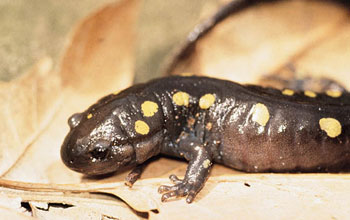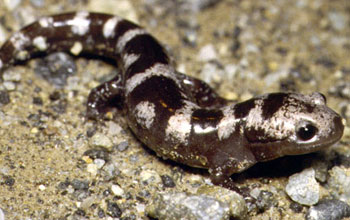Study of salamanders in ponds demonstrates 'invisible finger of evolution'.-

Spotted salamander: along with the marbled salamander, key to patterns of biodiversity.
Credit: Wikimedia Commons
Download the high-resolution JPG version of the image. (46 KB)

Scientist Mark Urban filters a tow net sample of zooplankton from a pond.
Credit: Daniel Buttrey
Download the high-resolution JPG version of the image. (4.2 MB)

The marbled salamander: top predator in here-today, gone-tomorrow ponds.
Credit: National Park Service
Download the high-resolution JPG version of the image. (458 KB)

A spotted salamander adult migrates to a temporary pond to breed.
Credit: Mark Urban
Download the high-resolution JPG version of the image. (1.6 MB)

Marbled salamander larva, patrolling the leaf litter in an ephemeral pond.
Credit: Nicole Freidenfelds
Download the high-resolution JPG version of the image. (630 KB)

Marbled salamanders shape the biological communities of temporary ponds.
Credit: Wikimedia Commons
Download the high-resolution JPG version of the image. (69 KB)
What do marbled and spotted salamanders in ponds in eastern North
America have to teach us about biodiversity patterns elsewhere on Earth?
Plenty, if research conducted by biologist Mark Urban of the University of Connecticut is any guide.
In a paper published today in the journal Proceedings of the Royal Society B, Urban reports results that may fundamentally change how scientists view the importance of evolution in ecological research.
"This
project looked closely at the separate and interactive contributions of
genetic and environmental factors in shaping pond food webs," says Alan
Tessier, program director in the National Science Foundation (NSF)'s
Division of Environmental Biology, which funded the research.
"The
results add to a growing understanding of the importance of genetic
variation within species, and of eco-evolutionary processes in
explaining patterns of biodiversity."
The findings show that the
evolutionary divergence of populations is as important as biodiversity
patterns based on ecological features, such as the presence of a top
predator.
In this study, the subjects were the marbled salamander,
an apex, or, top predator, in temporary ponds; the spotted salamander;
and their shared zooplankton prey.
The marbled salamander breeds in the autumn. Its larvae grow under the ice of ephemeral ponds during winter.
As
a result, marbled salamander larvae eat zooplankton all winter--and
grow large enough to eat the spotted salamander larvae that hatch in
these same ponds in late spring.
But Urban discovered that
spotted salamanders sharing space with marbled salamanders have evolved
so that they're born with voracious appetites.
Their increased
foraging makes sense, he says, given that these salamanders live in
ponds largely depleted of zooplankton prey, due to the presence of
marbled salamanders.
The smaller salamanders need to grow quickly to reach a size at which marbled salamanders can't easily capture them.
"The
evidence suggests that the repeated evolution of high foraging rates in
spotted salamanders is an adaptive response to marbled salamander
predation," says Urban.
Knowing how apex predators such as marbled
salamanders structure biological communities, he says, requires that
scientists understand their direct ecological effects as predators, and
their indirect effects via the natural selection they impose.
"Finding
that adaptive evolution may disguise strong ecological effects means
that a range of ecological predictions are likely to be unreliable if we
ignore how evolution affects biological communities."
Urban
refers to this as "the invisible finger of evolution" which, he says,
may tip the scales toward or away from ecological influences.
"That
the effect of an apex predator can be so strong that it causes
evolutionary responses in other species," he says, "shows that ecology
and evolution are inexorably intertwined."
-NSF-
Media Contacts
Cheryl Dybas, NSF (703) 292-7734 cdybas@nsf.gov
Sheila Foran, University of Connecticut (860) 486-3530 sheila.foran@uconn.edu
Sheila Foran, University of Connecticut (860) 486-3530 sheila.foran@uconn.edu
The National Science Foundation (NSF) is an independent federal
agency that supports fundamental research and education across all
fields of science and engineering. In fiscal year (FY) 2012, its budget
was $7.0 billion. NSF funds reach all 50 states through grants to nearly
2,000 colleges, universities and other institutions. Each year, NSF
receives about 50,000 competitive requests for funding, and makes about
11,500 new funding awards. NSF also awards about $593 million in
professional and service contracts yearly.
Useful NSF Web Sites:
NSF Home Page: http://www.nsf.gov
NSF News: http://www.nsf.gov/news/
For the News Media: http://www.nsf.gov/news/newsroom.jsp
Science and Engineering Statistics: http://www.nsf.gov/statistics/
Awards Searches: http://www.nsf.gov/awardsearch/
NSF Home Page: http://www.nsf.gov
NSF News: http://www.nsf.gov/news/
For the News Media: http://www.nsf.gov/news/newsroom.jsp
Science and Engineering Statistics: http://www.nsf.gov/statistics/
Awards Searches: http://www.nsf.gov/awardsearch/
The National Science Foundation (NSF).-
ayabaca@gmail.com
ayabaca@hotmail.com
ayabaca@yahoo.com
Inscríbete en el Foro del blog y participa : A Vuelo De Un Quinde - El Foro!

No hay comentarios:
Publicar un comentario